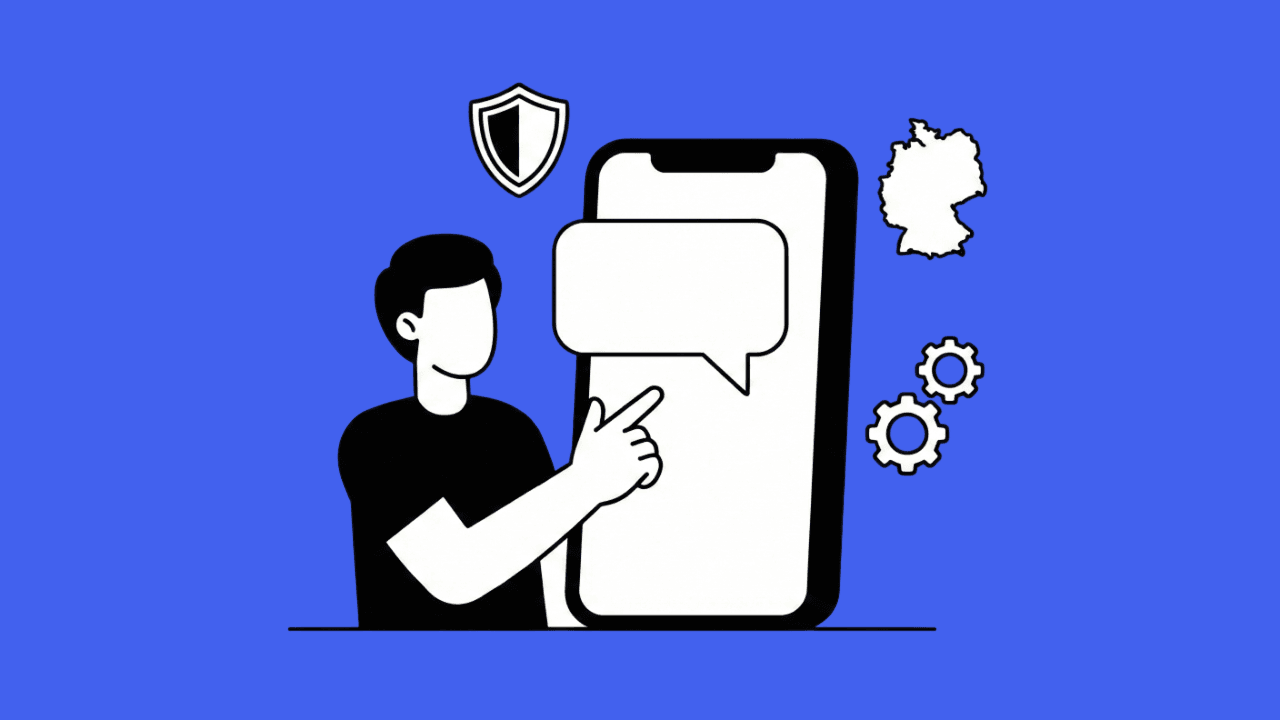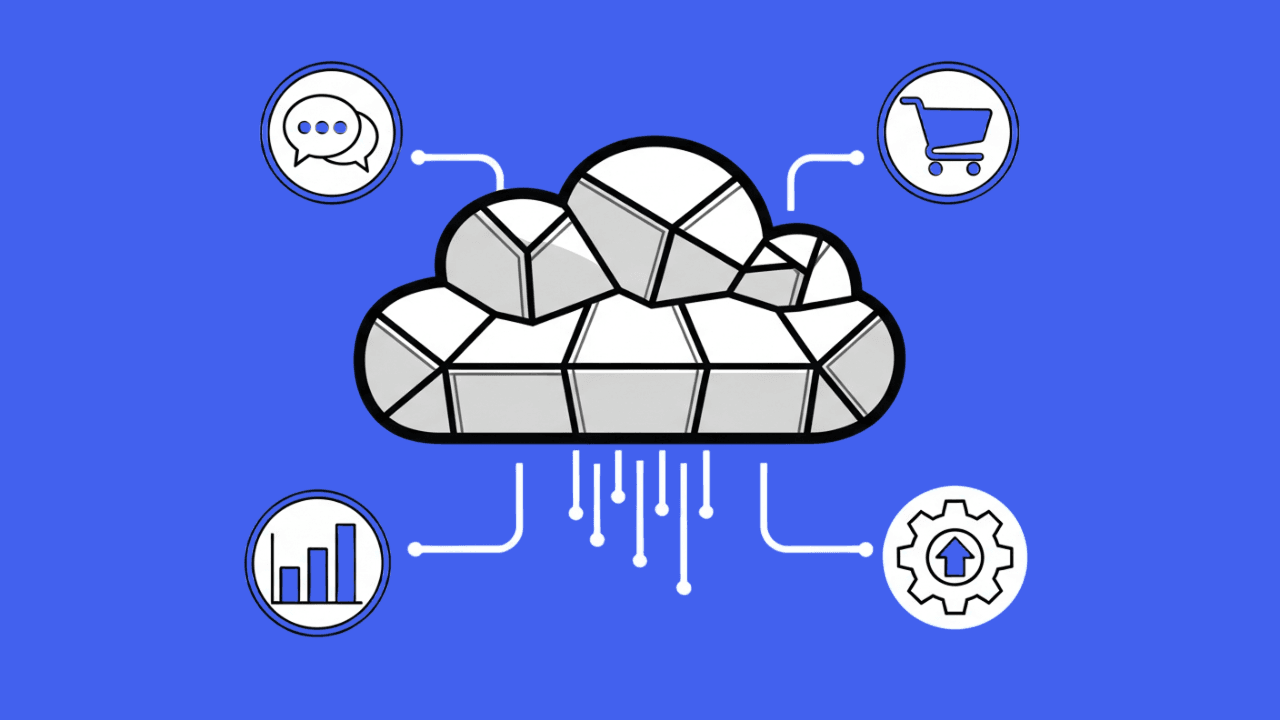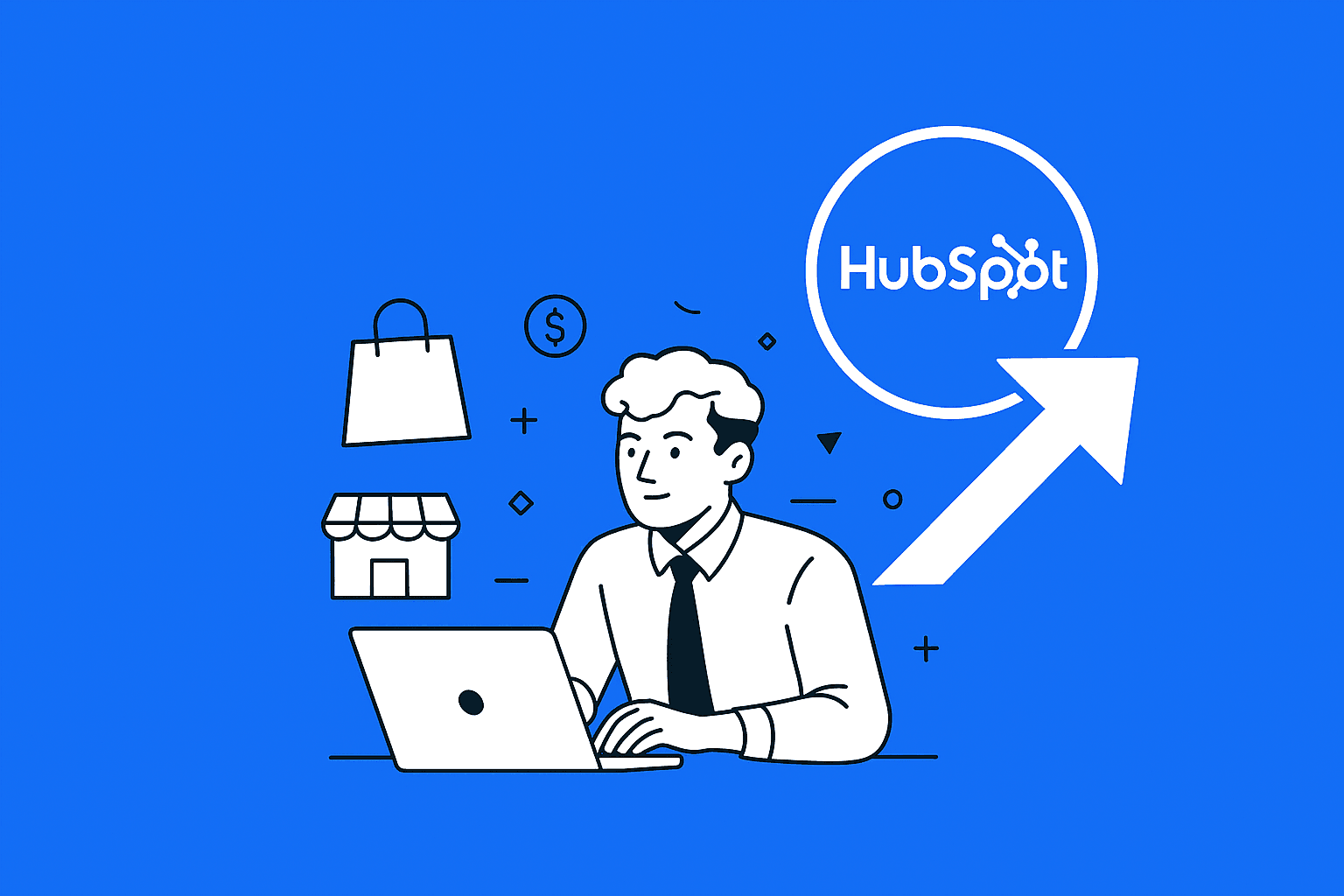In the dynamic e-commerce market, the quality of customer communication now determines business success. Automated customer communication stands for a new era of efficiency, speed, and personalization – and has long been a must for online retailers, brands, and agencies to increase customer satisfaction and sustainable growth.
What is automated customer communication?
Automated customer communication describes the targeted use of modern software such as artificial intelligence, chatbots, and process automation to handle inquiries, service processes, and marketing communication efficiently and at scale – with minimal manual effort.
Typical use cases:
- Handling shipping or returns inquiries
- Proactive customer outreach via email, WhatsApp & messenger
- Automated handling of support cases
Goals:
- Faster responses
- Reliable information
- High service quality
- Relief for teams
Advantages:
- Reduction of support costs
- Round-the-clock availability
- Consistent communication across all channels
- Higher customer satisfaction and brand loyalty
- Scalability without additional staff
This is where AI, chatbots, and cloud platforms interlock. Specialized solutions – especially in e-commerce – enable central control across email, live chat, messenger, and social media. The result: brand-compliant touchpoints that delight customers and deliver a measurable ROI.
Customer communication vs. customer service:
- Customer communication includes all interactions with customers – from marketing to order confirmations to proactive outreach on WhatsApp or social media.
- Customer service is part of this and focuses specifically on support cases, problem-solving, returns, and refunds.
A brief look back
The development of automated customer communication began with simple email automations (e.g., newsletters or order confirmations), later expanded through rule-based chatbots for FAQs – and today reaches a new level with AI-powered workflows. Modern systems automatically recognize concerns and customer inquiries, prioritize tickets, personalize content, and connect all channels in a central platform.
Key technologies: chatbots, contact center, cloud & artificial intelligence
Customer Service Chatbots are often the heart of automated customer communication. They answer frequent inquiries, guide customers through self-service portals, and provide reliable information around the clock – also in parallel across multiple channels. Thanks to AI technology and modern Natural Language Processing (NLP) modules, they understand context, recognize sentiment, and can proactively initiate follow-up questions or reviews.
Contact center solutions bundle all communication channels – from email and phone to WhatsApp and Instagram Direct Message – on one platform. Cloud-based systems make it possible to manage all processes remotely, independent of location, and at scale. They reduce IT effort and facilitate the integration of CRM systems, email marketing tools, and shop software such as Shopify or WooCommerce.
The integration of AI technologies elevates automated customer communication to a new level: automated sentiment analyses, context interpretation, smart routing functions, and personalized recommendations create a more individual customer experience – with maximum control and transparency.
The most important advantages of automated customer communication
1. Fast response times and 24/7 support
Through automation you respond in seconds, not hours. Customers receive immediate answers at any time of day or night, can directly query order status, deliveries, or product recommendations – no more waiting-on-hold frustration.
2. Scalability & efficiency gains
Whether seasonal peak or sudden surge: automated systems scale as needed – regardless of team size or inquiry volume. Recurring tasks are handled without additional effort, while your team can focus on more complex customer issues. Studies show efficiency gains of up to 50% and more.
3. Cost savings and team relief
Reducing manual work drastically lowers the cost per inquiry. A lean service team can reliably manage larger volumes of contacts. At the same time, sources of error are minimized and resources are freed up specifically for value-adding tasks.
4. Increase in customer satisfaction & brand loyalty
Customers appreciate fast, relevant, and individual communication. Automated processes ensure a constant service level, less frustration, and more satisfaction. Through proactive outreach (e.g., shipping notifications, discount promotions, or feedback requests) you actively increase loyalty and meet rising customer expectations.
5. Personalization through data-driven workflows
Modern systems consolidate customer data from CRM, shop, messenger, and social media. This allows you to personalize every interaction – whether offer email, status update, or targeted recommendations. Scatter loss decreases, conversion rates rise.
6. Integration into all relevant systems
Only through smart interfaces does automated customer communication unfold its full potential. AI chatbots, contact center, and marketing automation link CRM data, order histories, shipping info, and social channels for a true omnichannel experience.
Core functions and examples in e-commerce
A look at practice shows how automated customer communication delivers real added value in everyday shop operations:
| Application | Benefit for customers | Advantage for companies |
|---|---|---|
| WISMO ("Where Is My Order?") | Information on shipping status within seconds via chat, WhatsApp, email | Massive relief for customer service, direct customer loyalty |
| Returns management | Automatic acceptance of return requests including shipping label & status update | Fewer follow-up questions, self-service mode, transparent processes |
| Conversational sales | Advice, recommendations, product availability in chat, personal guidance through to purchase | Higher conversion, targeted upselling, stronger brand loyalty |
| Newsletter & segmentation | Automated delivery of news and offers based on interests and behavior | Maximum relevance, minimal scatter loss, better retention |
Particularly noteworthy is the area of conversational commerce: customers are reached where their communication habits are – e.g., with individual discounts via WhatsApp, personal product advice in Facebook Messenger, or proactive feedback on the ordering process right after purchase.
Comparison of the most important tools: from AI chatbot to e-commerce platform
In the e-commerce market, the number of specialized providers is growing rapidly. The following tools set standards in automated customer communication:
E-commerce support
| Tool / Platform | Special features | Ideal for |
|---|---|---|
| Chatarmin (ArminCX) | Specially for e-commerce, deep Shopify/WooCommerce integrations, GDPR-compliant WhatsApp support, fast live implementation | Online shops, D2C brands, conversational commerce |
| Gorgias | E-commerce customer support with shop integrations (Shopify, Magento, WooCommerce) | Online shops, D2C brands |
| Trengo | Omnichannel inbox, WhatsApp Business API, team collaboration | SMEs, multichannel communication |
| Tidio | Combination of live chat and chatbots, low entry prices | Small shops, startups |
Chatarmin (ArminCX)
Chatarmin is specifically developed for e-commerce and impresses with deep integration into Shopify and WooCommerce. With GDPR-compliant WhatsApp support, automated workflows, and fast live implementation, the platform increases conversion and customer satisfaction.
Gorgias
Gorgias is a helpdesk solution for online shops that connects seamlessly with Shopify, Magento, and WooCommerce. It enables automated responses, central ticket processing, and is particularly interesting for D2C brands.
Trengo
Trengo offers an omnichannel inbox that allows companies to manage WhatsApp, email, social media, and more in one central system. SMEs in particular benefit from simple team collaboration and efficient multichannel communication.
Tidio
Tidio combines live chat with chatbots into a cost-effective solution. Small shops and startups can quickly implement personalized customer communication on their website and automate support inquiries.
Chatbot specialists
| Tool / Platform | Special features | Ideal for |
|---|---|---|
| MoinAI | AI chatbots, versatile integrations, focus on large brands | Omnichannel service, central contact center |
| Userlike | Chat & messaging solution, GDPR-ready, many channels | Mid-sized companies, multichannel support |
| Parloa | AI solutions for voice & text, contact center automation | Voice-based customer interaction |
| Crisp | All-in-one messaging, shared inbox, automation | SMEs, e-commerce, multichannel |
| LiveChat | Classic chat solution, quick setup | Small to medium-sized companies |
MoinAI
MoinAI relies on AI-powered chatbots that can be integrated in many ways. With a focus on large brands and omnichannel service, the solution ensures efficient automation in contact centers.
Userlike
Userlike is a GDPR-compliant chat and messaging solution with support for many channels. It is particularly suitable for mid-sized companies that want to build multichannel support.
Parloa
Parloa specializes in voice and text automation. With a focus on contact centers, the platform enables AI-powered voice interactions and thus optimizes telephone customer service.
Crisp
Crisp is an all-in-one messaging tool with shared inbox, chatbots, and automation. It is suitable for SMEs and e-commerce companies looking for a flexible solution for multichannel communication.
LiveChat
LiveChat is a classic chat solution that is easy to set up. Particularly small and medium-sized companies use it to provide fast website support.
Enterprise CX platforms
| Tool / Platform | Special features | Ideal for |
|---|---|---|
| Salesforce Service Cloud | Enterprise solution, deep integrations, AI-powered processes | Corporations, international teams |
| Zendesk | Comprehensive customer service software, self-service portals, large community | Online retailers, mid-market to enterprise |
| Genesys Cloud CX | Contact center platform with voice & omnichannel functions | Large companies, call centers |
| Twilio Flex | Highly customizable cloud contact center solution | Developer teams, individual CX setups |
Salesforce Service Cloud
Salesforce Service Cloud is considered the industry standard in the enterprise segment. With AI-powered processes, deep integrations, and global scalability, it is ideal for corporations and international teams.
Zendesk
Zendesk is comprehensive customer service software with multichannel support, self-service portals, and a large community. It is suitable for online retailers as well as large enterprise customers.
Genesys Cloud CX
Genesys Cloud CX offers a powerful contact center platform with voice and omnichannel functions. Particularly large companies and call centers rely on this solution to optimize the customer experience.
Twilio Flex
Twilio Flex is a highly customizable cloud contact center solution. It is aimed at developer teams that want to build customized CX setups and retain full control over integrations.
All-rounders & mid-market
| Tool / Platform | Special features | Ideal for |
|---|---|---|
| Freshworks | All-in-one platform for support, CRM & automation | SMEs, multichannel support |
| HubSpot Service Hub | CRM-native, strong automations, integrated with marketing & sales | Scaling brands, inbound-driven companies |
| Intercom | Conversational support, in-app messaging, automations | SaaS, startups, app-based services |
| Drift | Conversational marketing, lead generation via chat | B2B sales, marketing automation |
Freshworks
Freshworks is an all-in-one platform for support, CRM, and automation. It is aimed primarily at SMEs and offers simple multichannel communication combined with strong automation.
HubSpot Service Hub
The HubSpot Service Hub complements the CRM ecosystem with a strong focus on customer experience. Through automations and seamless integration into marketing and sales, it is suitable for scaling brands and inbound-driven companies.
Intercom
Intercom combines conversational support with in-app messaging and automations. SaaS companies and startups in particular benefit from the ability to reach customers directly in the app or on the website.
Drift
Drift is a conversational marketing platform focused on lead generation via chat. It primarily supports B2B companies in sales and ensures that prospects are connected more quickly with the right contact person.
Tip: Check your individual requirements before choosing a tool. Simple chatbots are sufficient for classic FAQ bots – for deep conversational sales, returns, and true omnichannel experiences, Chatarmin is a leader in the DACH region and scores with fast implementation and high flexibility.
Step-by-step: successfully implementing automated customer communication
- Analyze the status quo: Where do recurring, manual tasks arise in support and marketing (e.g., WISMO, returns, shipping)?
- Define goals and channels: What do you want to automate? Which channels and systems (CRM, shop, messenger, social) are central?
- Tool comparison & selection: Test platforms like Chatarmin (e-commerce), MoinAI, Parloa, or Userlike – consider integration options, GDPR, personalization, and workflow depth.
- Implementation & testing: Start with selected use cases (e.g., shipping info, standard inquiries), analyze feedback, and iteratively improve workflows.
- Change management: Create acceptance in the team – train employees, explain goals, and actively involve all departments.
- Monitoring & optimization: Monitor automated tickets, customer satisfaction, cost savings, and conversion. Regularly optimize processes and use customer feedback as a lever for better communication.
Best practices: No isolated solutions! Rely on open, API-based tools, integrate current shop and CRM systems, and enable cross-channel, data-driven communication.
The future of customer communication: AI and automation
The future of customer communication will be significantly shaped by AI agents and Large Language Models (LLMs). While simple FAQ bots have so far only been able to deliver standardized answers, the systems are evolving into fully integrated CX automations. AI agents independently handle complex dialogues, prioritize tickets, analyze sentiment in real time, and forward only truly critical cases to human employees.
From FAQ bot to holistic experience automation
Context understanding & personalization: LLMs make it possible not only to react to questions but to actively recognize needs and propose tailor-made solutions.
Seamless integration: AI workflows integrate directly into shop systems, CRM, and ERP solutions and autonomously manage orders, returns, or subscription management.
Hyperautomation: Every customer interaction – whether marketing, service, or sales – is orchestrated across channels, from WhatsApp and email to voice dialogues via voice AI.
Hybrid models: Humans and AI work hand in hand – the AI handles routine, individual consultation remains with the team.
Leading platforms like Chatarmin are taking the lead: with GDPR-compliant AI agents, WhatsApp and Shopify integrations, and modern cloud architectures, they create the basis for scalable, personalized, and future-proof customer communication.
For e-commerce brands, this means more efficient processes, higher conversion, and a measurable improvement in the customer experience.
Conclusion: automated customer communication as a success factor for e-commerce companies
The days of chaotic email inboxes and long waits for answers are over. With automated customer communication, you gain speed, control, personalization – and offer customers the service level they expect today.
The leading solutions on the market – above all Chatarmin for e-commerce – not only make your customer service more efficient but turn communication into measurable business success. Whether D2C brand, growing shop, or international brand: now is the time to rethink processes, optimize service costs, and build brand trust.
Frequently asked questions (FAQ)
What does automated customer communication mean?
Automated customer communication describes the use of technologies such as AI, chatbots, or workflow automation to handle inquiries and interactions efficiently, at scale, and without manual effort. It plays a central role in modern business processes and facilitates knowledge transfer between teams and customers. The goal is to meet customer expectations, solve problems early, and thus give companies a clear competitive advantage.
What is automated customer service?
Automated customer service includes the system-supported processing of support inquiries – from standard cases like WISMO (“Where Is My Order?”) to returns processes and self-service portals. Assistants such as AI agents or chatbots take over routine tasks, while employees handle complex problems. This makes a significant contribution to the importance of a seamless customer journey.
What are the advantages of automated communication?
- Faster response times through immediate answers.
- Relief of support teams, as routine inquiries are resolved automatically.
- Consistent customer experience across all channels.
- Cost reduction through more efficient processes.
- Personalization based on real-time data and customer history.
In addition, automation offers many possibilities: it can be implemented in different forms – from automated emails to chatbots to intelligent assistants that are embedded directly on the website.
Which tools are there for customer communication?
Leading tools include Zendesk, Freshworks, Userlike, and HubSpot for classic support. In e-commerce, Chatarmin (ArminCX) is establishing itself as a specialized CX solution – with GDPR-compliant WhatsApp integrations, WISMO workflows, and voice AI.
Such tools not only provide help with operational tasks but also valuable insights for optimizing business processes and strategic direction.
What examples are there in practice?
- WISMO inquiries: Automatic shipping status updates via WhatsApp or email.
- Returns management: Independent acceptance of returns with label creation.
- Conversational sales: Advice and product recommendations in chat.
- Newsletter & segmentation: Automatic delivery of individual offers.
Such practical examples are often prepared in articles or internal documentation. They help companies systematically secure valuable knowledge, make it usable across teams, and thus sustainably increase efficiency along the entire customer journey. At the same time, they show how a product proves itself in practice and which challenges can be successfully solved by using automated communication.
Test Chatarmin today – our experts will show you in a demo how automated customer communication can take your shop to the next level within days.
Benefit from immediately measurable successes in support, sales, and customer loyalty – personal, scalable, GDPR-compliant.








